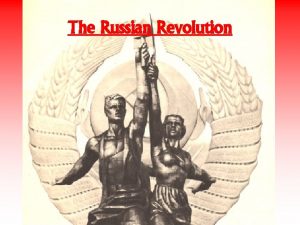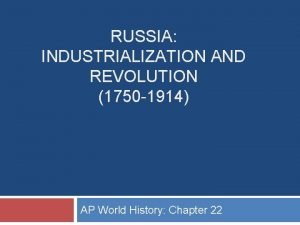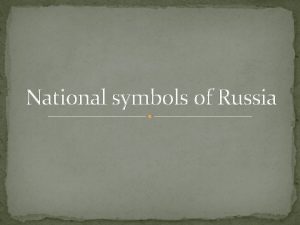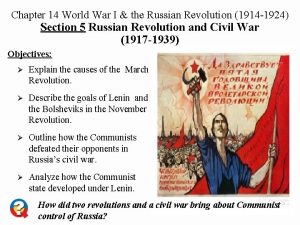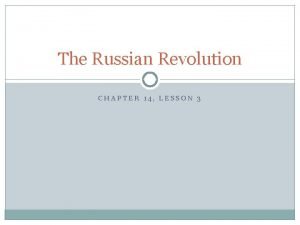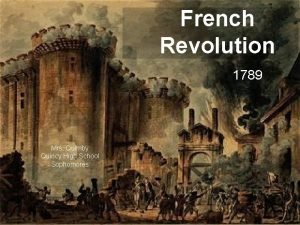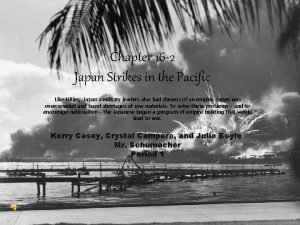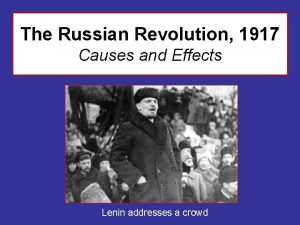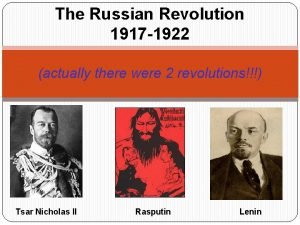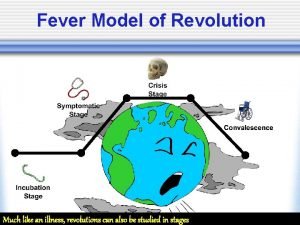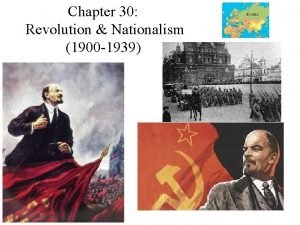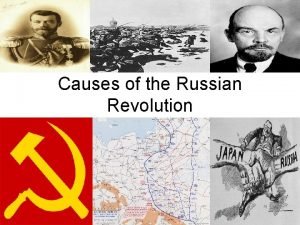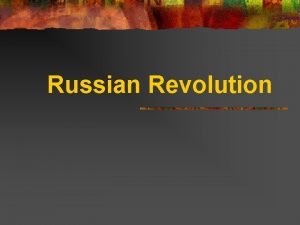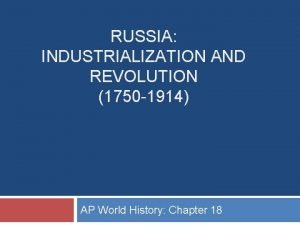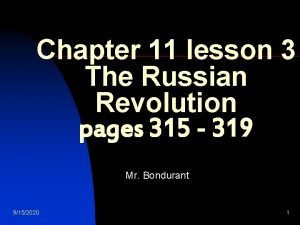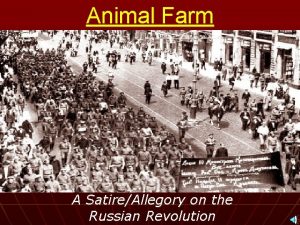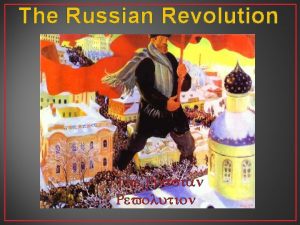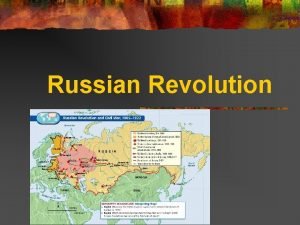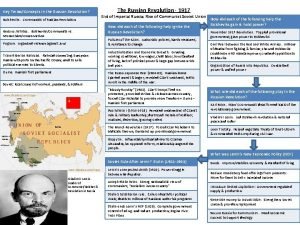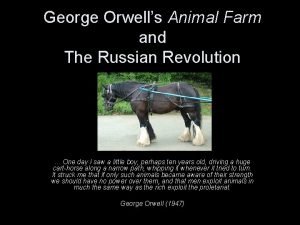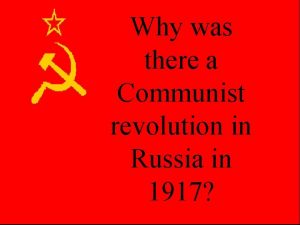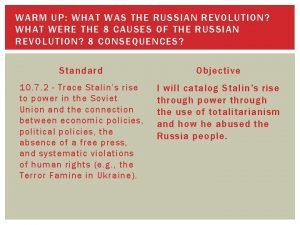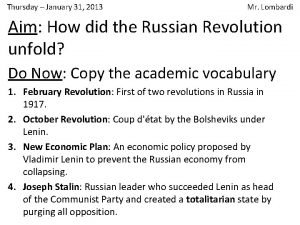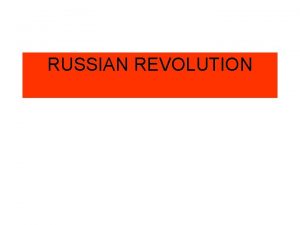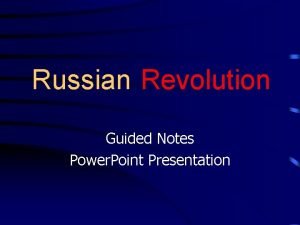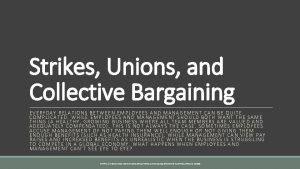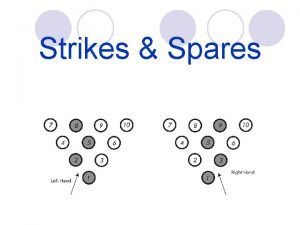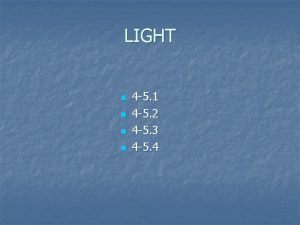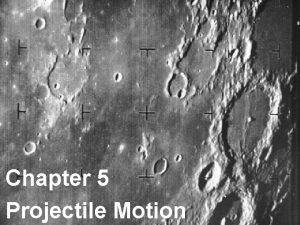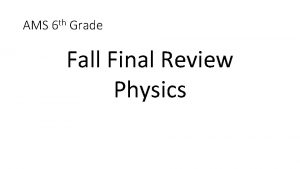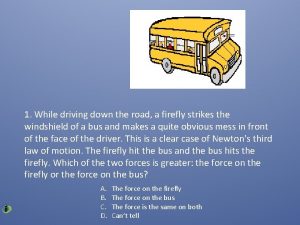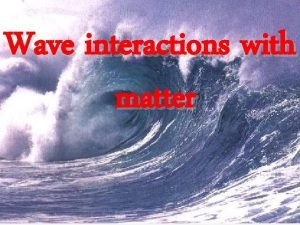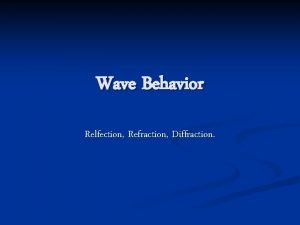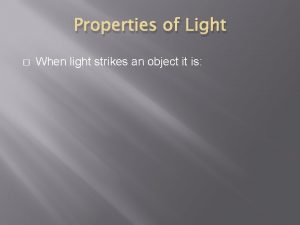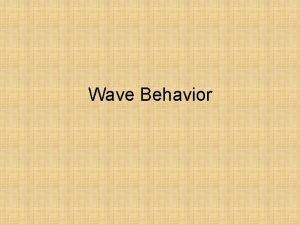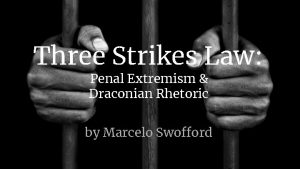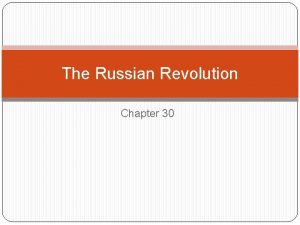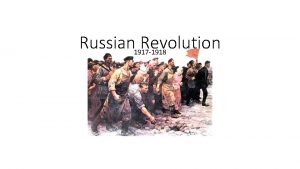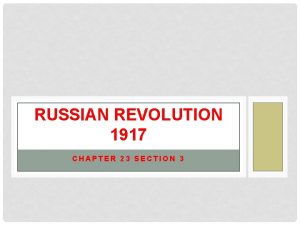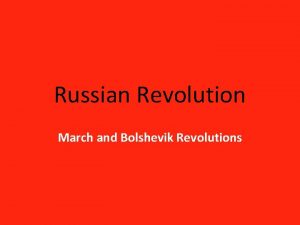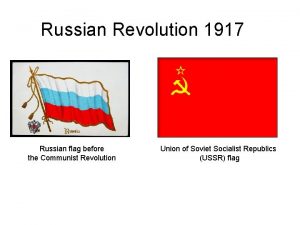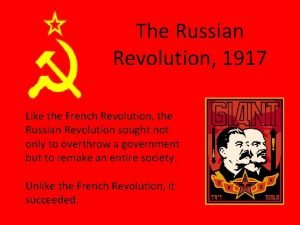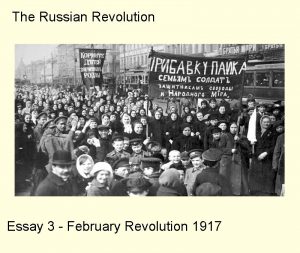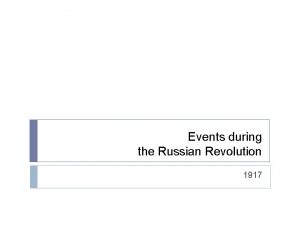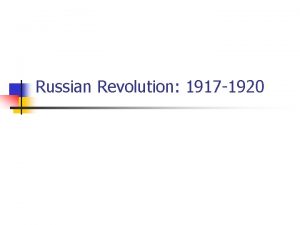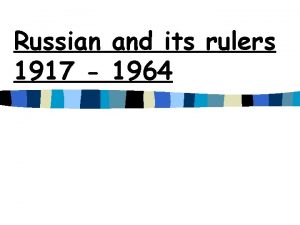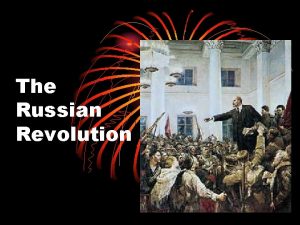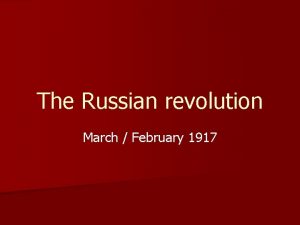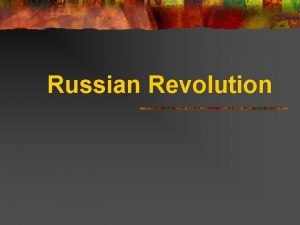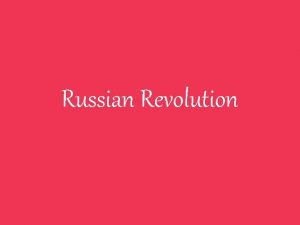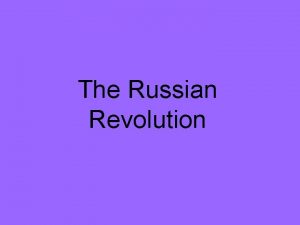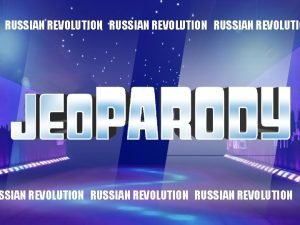The Russian Revolution Chapter 30 March 1917 strikes














































- Slides: 46

The Russian Revolution Chapter 30

� March 1917 – strikes and food riots broke out in Russia’s capital, Petrograd (renamed St. Petersburg in 1991) � Misery of WWI � Conditions of early industrialization � Incomplete rural reform � Unresponsive political system � Rioters wanted food, work, and a new political regime � A council of workers (called a soviet) took over the city government and arrested the tsar’s ministers � Tsar Nicholas abdicated, the Duma declared Russia a republic The Russian Revolution

Left: Armed workers and soldiers escorting captured policemen. Petrograd, 1917 Right: workers protesting in the streets

Liberalism to Communism � After the March 1917 revolution a liberal provisional government struggled to rule country �Ruled for only eight months �Liberalism not deeply rooted in Russia �Refused to withdraw from WWI �Increased economic misery and popular discontent �Held back from massive land reforms, leaving peasants unhappy � Serious popular unrest continued… �In November (October, by the Russian calendar), a second revolution expelled liberal leadership �The Bolshevik leader, Lenin,

� A civil war followed between those who supported Lenin’s program and those who wished to return to the rule of the Tsar �“Reds” – supporters of Lenin � Were victorious (secured the position of the new Communist government) � Had support of the peasants and workers �“Whites” – supporters of a Tsar � Had support from the United States � After winning the civil war, Lenin executed Tsar Nicholas II and his family

�Lenin and the Bolsheviks (Russian Communist Party) faced several immediate problems � 1917 - Brest-Litovsk treaty �Humiliating peace treaty with Germany �Gave up part of western Russia in return for an end to hostilities �Nullified after WWI �Russia ignored at Versailles peace conference �Communist beliefs �Internal political rivals �Social Revolution Party – emphasized peasant support

� 1918 -1921: internal civil war continued �Tsarist generals, religiously faithful peasants, and minority nationalities fought against the communist regime �Suffered continuing economic distress �Once in power, Lenin quickly decreed a redistribution of land to the peasants and nationalized (government takeover) basic industry �Created widespread opposition, particularly among landed

Stabilization of the New Regime � Communist leadership would restore order on several key foundations �Powerful new army � Red Army � Under the leadership of Leon Trotsky � 1921 – New Economic Policy � Some private ownership was allowed in small-scale manufacturing and agriculture � State continued to set basic economic policies, but combined that with individual initiative

� 1923 - New constitution set up a federal system of socialist republics, known as the Union of Soviet Socialist Republics. �Ethnic Russians would control central government �Certain groups (especially Jews) given no representation

� 1924 – Lenin died; Joseph Stalin emerges as leader of Soviet state � Stalin represented a strongly nationalist version of communism �Represented the anti-Western strain in Russian tradition �Rival leaders were killed or expelled

Building Soviet Society �The mid-1920 s were a surprisingly open-ended period in Soviet history �Youth movements, women’s groups, and particularly organizations of workers all actively debated policies �Workers were able to influence management practices, and women’s groups helped carve out legal equality and new educational and work opportunities for their members �Rapid spread of education �Beliefs in communist political analysis and science �Literacy gained ground

Stalinism � 1927 – Joseph Stalin acquired full power over potential rivals �Authoritarian control �Renewal of socialism � Lenin’s New Economic Plan had moved away from socialism and was terminated � By this time, the majority of land was in the hands of a minority of wealthy, commercially oriented peasants (kulaks) �Profit-based market agriculture � Stalin wanted an industrial society in full control the state (a noncapitalist modernization) �Willing to borrow Western techniques and advice, but insisted

Centralized Economic Policies � 1928 - Collectivization – Large, state-run farms rather than individual holdings (like the West) �Would make peasants share scarce machines while increasing Communist party control �Communist party agitators pressed peasants to join in collectives �Most kulaks refused to cooperate, often destroying livestock and other property rather than submitting to collectivization � Caused devastating famine � Early 1930 s – millions of kulaks were killed or deported to Siberia �Never successful

� Under Stalin, the government built massive factories for metallurgy, mining, and electric power to �Five-year plans – set clear priorities for industrial development, including expected output levels and new facilities �Made Russia an industrial country independent of Western-dominated world banking and trading patterns �Russia’s great natural resources prepared for possible war with Hitler’s anticommunist Germany �Rapid industrial growth occurred � During the first two five-year plans, to 1937 - (while West is experiencing economic

Toward and Industrial Society � Increasing numbers of people were crowded into inadequate housing �Government reluctant to put too many resources into housing � Factory discipline was strict as communist managers tried to instill new habits into former peasants � Communist policy quickly built up a network of welfare services �Even more than the West

Totalitarian Rule � Stalin combined his industrialization program with a new intensification of government police procedures �Used the party and state apparatus to monopolize power even more than Hitler’s state attempted �Opponents and imagined opponents of his version of communism were executed � 1937 -1938: the great purge � Hundreds of party leaders intimidated into confessing imaginary crimes against the state o Most put to death � Thousands of people sent to Siberian labor camps �News outlets were monopolized by the state the party � 1934 - Secret police renamed Ministry of Internal Affairs �Atmosphere of terror spread in Soviet Society


�In foreign policy, Stalin had to pay close attention to Nazi Germany �Hitler hated the Slavic peoples and communism, and wanted to create a “living room” for Germany to the east �Stalin initially hoped that he could cooperate with Western democracies in blocking the German threat �Cooperated in the Spanish Civil War in 1936 and 1937 , but France and Britain incapable of forceful action and were suspicious of the Soviets

� 1939 – Ribbentrop-Molotov pact �Stalin’s historic agreement with Hitler �Bought some time for greater war preparation �Enabled Soviet troops to attack eastern Poland Finland �Regain territories lost in WWI �Revival of Russia’s long interest in conquest �The Nazis, after occupying France and being defeated in Britain, turn east towards the Soviet Union

�The Soviet Union’s new industrial base proved vital in providing the material needed for war �Cities such as Leningrad and Stalingrad were overwhelmed by Germans for months, with huge loss of life � 1943 – Red Army pressed westward �Russia was able to regain its former

The Soviet Union as a Superpower � Soviet Union emerged as a world power �Industrialization � Weapon development – atomic and hydrogen bombs �WWII push westward �Established a protectorate over the communist regime of North Korea to match the American protectorate in South Korea �Aided the victorious Communist party in China � 1970 s – New ally in communist Vietnam � Provided naval bases for Russian fleet �Growing military and economic strength gave the postwar Soviet Union new leverage in the Middle East, Africa, and even parts of Latin America

The New Soviet Empire in Eastern Europe � Clearest extension of the Soviet sphere developed right after WWII in eastern Europe � Helped launch the cold war � The small nations of eastern Europe (mostly new or revived after WWI) had gone through a troubled period between the world wars � Vulnerable to Nazi and then Soviet advances � By 1918 -Consumed by nationalist excitement at independence � Bitter rivalries weakened them diplomatically and economically � Most went from democratic to authoritarian governments � Poland – dictator � Yugoslavia - monarch � Social tensions � Remained primarily agricultural and heavily dependent on sales to western Europe � Hurt by the depression

� The Nazis would attack eastern Europe �Ineffective Western response �Czechoslovakia, Poland, and Yugoslavia seized by German or Italian forces � Several other east European authoritarians allied themselves directly with Hitler �Shared ideological leanings �Fear of the Soviet Union � Eastern Europe fell under Nazi control for four years �Compelled to provide troops and labor for Hitler

� 1943 -The Red Armies directly liberated all of eastern Europe and the eastern part of Germany to the Elbe River �Exceptions: Greece and Yugoslavia � 1945 -1948 – Soviet military might and collaboration with local communist movements crushed opposition parties and forced out

� Early 1950 s – New Soviet- sponsored regimes �Attacked possible rivals for power � Including Catholic church �Implemented mass education and propaganda �Collectivization of agriculture ended the large estate system �Industrialization was pushed through successive five-year plans �After formation of NATO, most east European nations joined the Warsaw Pact � Common defense alliance �Soviet troops stationed throughout Eastern Europe � Confront the Western alliance


� 1953 – dissatisfaction with tight controls in East Germany brought workers’ uprising �Repressed by Soviet troops �Widespread exodus to West Germany � 1961 – Berlin Wall built to contain the flow � All along the new borders of eastern Europe, barbed wire fences and armed

� 1956 – relaxation of Stalinism �More liberal communist leaders arose in Hungary and Poland, creating greater freedom within communism �Poland � Allowed to halt agricultural collectivization, establishing widespread peasant ownership of land � Catholic Church gained greater tolerance �Hungary � New regime was cruelly crushed by Soviet army and replaced by hard-lined Stalinist leadership

Evolution of Domestic Policies �After WWII – Stalinist policies continued �Strict Communist party and police controls �After 1947 – news media blasted America as an evil power and corrupt society �Fearful of a new war with the U. S. , many agreed to a strong national government �Mid 20 th century - Strict limits on travel and outside media kept the Soviet Union isolated �Culture and economy removed from world patterns �Politically – emphasis on central controls �Party membership was necessary to bureaucratic promotion � 6% of population belonged to Communist Party

Soviet Culture: Promoting New Beliefs �Government and Communist Party cultural agenda �War on Orthodox church and other religions to create a secular society �Did not try to abolish the Orthodox church outright � Barred from giving religious instruction to anyone under 18 �Limited freedom of religion for Jewish minority �Marxist, scientific orthodoxy �Artistic, literary styles, and political writings were monitored carefully to ensure that they were pro-Communist Party �Educational system was used to create a loyal, pro. Communist youth �Train and recruit technicians and bureaucrats � Opposed Western cultural elements of the 19 th century tsarist elite �Modern Western styles of art and literature were attacked as corrupt

�Soviet culture placed strong emphasis on science and social science �Scientists enjoyed great prestige and power �Research heavily funded by government �Several fundamental discoveries in physics, chemistry, and mathematics �Contributed to technology and weaponry

Economy and Society � Between 1920 s to 1950 s- Soviet Union became industrial society �Manufacturing grew rapidly �City populations rose to more than 50 percent of population �By 1950 s – most of Eastern Europe was industrialized �State control of nearly all economic sectors � Lagged in the priorities it placed on consumer goods � Automobiles, housing construction �Complaints about poor consumer products and long lines to obtain desired goods remained a feature

�Soviet family reacted to some of the same pressure of industrialization the Western family experienced �Massive movement to the cities and crowded housing �Nuclear family unit �Birth rate dropped �Declining infant death rates �Improved diets and medical care �Children more strictly disciplined than the West �Most married women worked �essential feature of an economy struggling to industrialize �Performed many heavy physical tasks �dominated some professions, such as medicine

De-Stalinzation � 1953 – Stalin dies �Gradual loosening of Stalin’s cultural isolation � 1956 – Nikita Khrushchev �Attacked Stalinism for its concentration of power and arbitrary dictatorship �Condemned Stalin for his treatment of political opponents and failure in preparing for WWII �Decentralized some decision making �Police repression eased �Outright critics of regime less likely to be executed � Sent to psychiatric institutions instead

� From Khrushchev’s fall from power into 1980 s �Soviet Union remained stable � Recurrent worries over sluggish productivity compelled expensive grain deals with Western nations, including the United States �Cold War policies eased �Soviet desire to beat the West in industry � 1962 – Soviet government installed missiles in Cuba (Cuban Missile Crisis) �Khrushchev had no desire for war, and

� Khrushchev wanted to beat United States economically � 1957 – Sputnik �First satellite send into space � 1961 – Yuri Gagarin was first manned flight into space � 1960 s – greater access to Western media �Lowered cold war tensions with the West � 1970 s – Soviet Union invaded Afghanistan �Desire to create puppet regime � 1980 s – problems of work motivation and discipline �Lack of consumer goods �Many workers found little reason for great diligence �High rates of alcoholism � Increased death rates

The Explosion of 1980 s and 1990 s � 1985 onward �intensive reform �Soviet Union would begin to dismantle � Deteriorating Soviet economic performance � Costs of military rivalry with the United States

Economic Stagnation �By 1980 s – Stagnant economy �Rigid central planning �Health problems �Extensive environmental damage throughout Eastern Europe � Half of all rivers severely polluted � 40% of agricultural land endangered �High rates and severity of respiratory and other diseases �Highest infant mortality rates in the world �Military spending � 1/3 of national income �Poor worker morale

� 1985 – Mikhail Gorbachev �Western style, dressing in fashionable clothes �Open press conferences �Allowed Soviet media to engage in active debate and report on problems and successes �Reduction in nuclear armaments �Ended war in Afghanistan �Policy of glasnost – openness Reform and Agitation � New freedom to comment and criticize �Market incentives to grow economy �Still… strong limits on political freedom �Opened Soviet union to fuller participation in world economy � Mc. Donald’s in Moscow �Perestroika – economic restructuring � More private ownership � Decentralized control in industry and agriculture

� 1988 – Gorbachev encouraged a new constitution �Gave power to a new parliament �Congress of People’s Deputies �Abolished Communist monopoly on elections �Important opposition groups developed both inside and outside the party � Conservatives vs. Radicals � 1990 – Gorbachev elected President � 1988 onward - Despite reforms, continued economic stagnation provoked agitation among minority nationalities who wanted indepedence �Muslims and Armenian Christians rioted in the south �Baltic nationalists and other European minorities

� Many Eastern Europe states uniformly moved for greater independence � 1989 - Bulgaria � Communist leader ousted and free elections arranged � 1988 – Hungary � Changed leadership and installed a noncommunist president � 1988 – Poland � Installed a noncommunist government � Dismantle the state-run economy � 1989 – East-Germany � Expelled key leaders and moved rapidly toward unification with West Germany � Berlin Wall was dismantled and a noncommunist won a free election � 1989 – Czechoslovakia � Installed a new government � Introduced free elections � Market driven economy Dismantling the Soviet Empire

� Reform in eastern Europe (like in Soviet Union) was complicated by clashes between nationalities � Romanians and Hungarians fought � Bulgarians attacked a Turkish minority � Yugoslavia had clashes between rival Slavic groups � Bitter fighting broke out in Bosnia, with Serbs, Croats, and Muslims all fighting for territory � 1998 -1999 – bloody clashes between Serbs and Albanians in

Shocks in 1991: The End of the Soviet Union � 1991 – attempted government coup in Soviet Union �Gorbachev’s presidency and democratic decentralization were threatened �New attacks on the Communist party �New independence movements by minority nationalities �Baltic republics declared independence again � widespread international recognition �European borders – Belarus, Ukraine, Moldova �Muslim areas of Central Asia

�December 1991 – the Soviet Union was dismantled and replaced by a loose union of the successor republics �The Commonwealth of Independent States �Most of the republics, which had been tied into the larger Soviet economy,

� Boris Yeltsin - Elected president of the Russian Republic �Communist party dissolved �Struggled to gain a political base � Pitted against the parliament, composed mainly of former communists � 1993 – Yeltsin and army emerged victorious when an armed clash emerged �Another constitution written, designed to stabilize democracy �Economic reforms – more private enterprise with protection for some state-run operations �Diplomatically – Continued collaboration with the West �Cultural creativity remained high, with greater freedom to publish � Limited funding for scientific research � Late 1990 s – economy remained very weak �Production levels down �Supplies to consumers uncertain �High unemployment �Economy came to near collapse as the value of the ruble plummeted �Organized crime gained ground

Conclusion: What’s next? �Recent trends in Russian history demonstrate that Russia and East Europe had changed relatively little in some ways during the twentieth century. �Ethnic differences continue to divide the new nations of the post-Soviet era �Religion continued to remain a vital force �Russia remained attracted to Western culture, including the concepts of political liberty and a market economy �Strong, central authority remains and democracy has not been well-established
 March 1917 revolution
March 1917 revolution Industrialization definition ap world history
Industrialization definition ap world history Russian revolution 1917
Russian revolution 1917 Russian revolution vs french revolution
Russian revolution vs french revolution Russian national symbols
Russian national symbols Anthem of poland
Anthem of poland World war 1 and the russian revolution chapter 27
World war 1 and the russian revolution chapter 27 Chapter 14 world war 1 and the russian revolution
Chapter 14 world war 1 and the russian revolution Chapter 14 lesson 3 the russian revolution
Chapter 14 lesson 3 the russian revolution Sansculottes
Sansculottes Japan strikes in the pacific
Japan strikes in the pacific Causes and effects of the russian revolution
Causes and effects of the russian revolution Who lost territory after ww1
Who lost territory after ww1 Russia after ww1
Russia after ww1 Russian revolution political cartoons
Russian revolution political cartoons Fever model of a revolution
Fever model of a revolution Chapter 30 revolution and nationalism worksheet answers
Chapter 30 revolution and nationalism worksheet answers Effect of russian revolution
Effect of russian revolution Http://www.history.com/topics/russian-revolution
Http://www.history.com/topics/russian-revolution Russian revolution of 1905 definition ap world history
Russian revolution of 1905 definition ap world history Lesson 3 the russian revolution
Lesson 3 the russian revolution Summary of animal farm
Summary of animal farm In the view of this cartoonist russia under
In the view of this cartoonist russia under The russian revolution
The russian revolution Russian revolution
Russian revolution The russian revolution
The russian revolution Introduction of russian revolution
Introduction of russian revolution Russian revolution effects
Russian revolution effects Causes of the russian revolution
Causes of the russian revolution Russian revolution
Russian revolution Russian revolution guided notes
Russian revolution guided notes You should hope that this game will be over soon
You should hope that this game will be over soon Third agricultural revolution definition
Third agricultural revolution definition Strikes unions and collective bargaining
Strikes unions and collective bargaining Strikes and spares
Strikes and spares Different properties of light
Different properties of light Example of transparent
Example of transparent Aristotle view of projectile motion
Aristotle view of projectile motion Miners strike 1912
Miners strike 1912 A car traveling at 100 km/h strikes an unfortunate bug
A car traveling at 100 km/h strikes an unfortunate bug While driving down the road
While driving down the road F
F Reflection refraction diffraction
Reflection refraction diffraction When light strikes
When light strikes Reflection is when a wave strikes an object and
Reflection is when a wave strikes an object and Gilded age labor strikes
Gilded age labor strikes Three strikes
Three strikes
